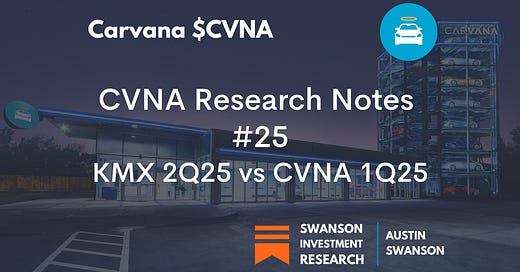Carvana ($CVNA): KMX 2Q25 vs CVNA 1Q25 (Research Note #25)
Analysis of Carvana's and CarMax's units and economics over time, through their latest earnings.
Following KMX’s latest earnings, I updated the CVNA vs KMX analysis with the latest numbers.
As a reminder, this CVNA Research Note compares and analyzes the units and economics between Carvana and CarMax over time, through their latest earnings.
KMX’s 2Q25-equivalent earnings, released on June 20, 2025.
CVNA’s 1Q25 earnings, released on May 7, 2025.
In general, the purpose of this Research Note is to be able to determine how well one is doing versus the other, under the many different components of their unit economics, and why (including areas where Carvana or CarMax is doing something fundamentally different).
Important Note: This is why the latest KMX developments are interesting, where they have taken notice of where CVNA is doing better, such as in finance GPU, and are now making changes.
In this specific report, the purpose is more to see how KMX’s latest quarter progressed, their updated trends, and their latest commentary. The other purpose is to have everything ready for comparisons to CVNA’s 2Q25 figures once they are released. I did include though the current run-rate for CVNA’s 2Q25 units, for comparisons to KMX’s latest numbers.
New Commentary
In addition to updating the numbers, new commentary was added to this update, related to KMX’s latest results and their earnings call. The following is a summary of the new commentary added.
KMX’s Non-Prime Securitization: KMX announced they are doing a non-prime securitization. This will have an associated gain on loan sales in the future, similar to what CVNA records. KMX also reiterated they are moving to lend on the full credit spectrum, and take back the lower credit score tiers that they have passed onto third parties (more subprime). This will help close the gap in the difference in finance GPU vs CVNA.
KMX’s Decrease in Finance GPU / CAF Income: While they had some growth in their net interest margin percentage, that was offset by an increase in their provision for loan losses (from ‘22 and ‘23 vintages and changes in economic assumptions, offset partially from releasing some provisions tied to the held for sale loans).
KMX’s Increase in Other GPU: Other GPU increased $134 per retail unit YoY, and $140 QoQ, to their highest level in years (and possibly ever). KMX mentioned this was driven by growth in service gross profit, which came from “cost coverage measures, positive retail unit growth, and increased efficiencies”. More specifically, the press release stated, “Service margin of $143 per retail unit, an improvement of $128 per retail unit". This not only stood out, but also Other Cost of Sales dropped to the lowest level in 10+ years (down to only $7M in the latest quarter, vs an average of $42M a quarter the last 4 quarters, an approx $150 per retail unit benefit), which led to it being asked about on the call.
1. Comparison Summary
Two quick things to keep in mind with the tables below:
Reporting Periods: CarMax has a slightly different reporting period. I share in the footnotes how I handle / organize for this to be comparable to CVNA1.
Unit Basis: All GPU and “per unit” figures below are a function of retail units, including for wholesale. I provide comparisons on a per-wholesale-unit basis later.
The following table is the updated comparison between KMX 2Q25 vs CVNA 1Q25. This table highlights the largest differences between CarMax and Carvana on a GAAP basis, and helps explain which sub components are contributing the most to Carvana’s higher total GPU and higher adjusted EBITDA per retail unit.



